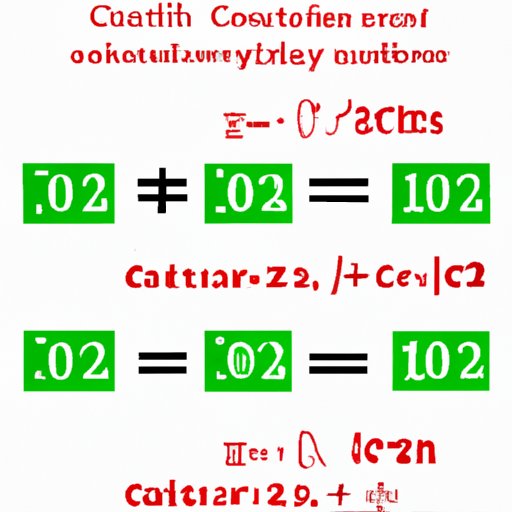
Introduction
Have you ever struggled to understand how to find the constant of proportionality? As one of the fundamental concepts in math, it is essential to master this concept in order to tackle more complex problems. The constant of proportionality describes the relationship between two variables in a proportional situation, and it is essential to understand how to find it. In this article, we’ll explore tips and tricks for finding the constant of proportionality, real-world examples, and step-by-step guides to solving common math problems.
Cracking the Code: Tips and Tricks for Finding the Constant of Proportionality
There are several ways to find the constant of proportionality in a proportional situation.
- Simplifying ratios to find the constant: This involves simplifying the ratio between the two variables until it is reduced to the simplest form. For example, if the ratio between x and y is 6:2, we can simplify it to 3:1. The constant of proportionality is 3.
- Using cross-multiplication: This involves cross-multiplying the numerator of one ratio with the denominator of the other ratio to find the constant of proportionality. For example, if the ratio between x and y is 6:2, we can cross-multiply to get 6y = 2x. The constant of proportionality is 3.
- Working with fractions: This involves setting up the ratios as fractions and finding the common denominator. For example, if the ratio between x and y is 6:2, we can set it up as 6/2 = x/y. The constant of proportionality is 3.
- Using algebraic equations: If the problem involves variables and equations, we can use algebra to find the constant of proportionality. For example, if 5x = 15y, we can divide both sides by 5 to get x = 3y. The constant of proportionality is 3.
The Secret Sauce of Proportions: Unveiling the Mystery of Constant of Proportionality
The constant of proportionality is a critical concept in several real-world scenarios. For example, in distance vs time problems, the constant of proportionality is the speed of an object.
It is also important to understand the relationship between variables and the constant of proportionality. As the variables change, the constant of proportionality remains constant. For example, if the ratio between x and y is 6:2, the constant of proportionality is 3. If the ratio between x and y is 12:4, the constant of proportionality is still 3.
The constant of proportionality can be represented in several ways, such as k, m, or any other letter. It is essential to know how to identify it in a problem to solve it correctly.
Step-by-Step Guide to Finding the Constant of Proportionality for Common Math Problems
Let’s look at some common math problems that involve finding the constant of proportionality and how to solve them step-by-step.
- Distance vs Time: If a car travels 300 miles in 5 hours, what is the speed of the car? The ratio between distance and time is 300:5. To find the constant of proportionality, we can simplify the ratio to get 60:1. The constant of proportionality is 60, which represents the speed of the car in miles per hour.
- Area vs Length or Width: If the area of a rectangle is 72 square meters, and the length is 9 meters, what is the width of the rectangle? The ratio between length and width is 9:x. To find the constant of proportionality, we can set up the ratio as a fraction 9/x = 72/1. We can simplify it to 8, and the constant of proportionality is 8 meters.
- Weight vs Price: If 6 pounds of beef cost $24, how much will 9 pounds cost? The ratio between weight and price is 6:24. We can simplify it to 1:4 and find the cost per pound as $4. Therefore, 9 pounds will cost $36.
It is essential to recognize when to use the constant of proportionality in problem-solving. Whenever there is a proportional relationship between two variables, we need to find the constant of proportionality to solve the problem accurately.
Unlocking the Key to Proportions: How to Find the Constant of Proportionality and Enhance Your Math Skills
Building a stronger understanding of the constant of proportionality requires practice, practice, and practice. Here are some strategies to enhance your math skills:
- Practice: Practice solving problems that involve the constant of proportionality to build your skills and confidence.
- Read: Read math textbooks and articles to deepen your understanding of mathematical concepts, including the constant of proportionality.
- Use online resources: There are several websites and apps that offer practice problems and tutorials to help you master the constant of proportionality.
- Get help: Don’t be afraid to ask for help from a tutor, teacher, or classmate if you are struggling to understand the concept.
From Beginner to Master: Building Your Understanding of the Constant of Proportionality with Real-World Examples
Let’s look at some more real-world examples that involve the constant of proportionality:
- Scaling: When resizing images or maps, the constant of proportionality determines how the dimensions will change.
- Recipes: Cooking recipes use proportional relationships to adjust the ingredient amounts for different serving sizes.
- Finance: Interest rates and taxes are based on proportional relationships.
Exercises for readers to practice applying their new knowledge:
- Solve the problem: If 8 pizzas cost $40, how much will 5 pizzas cost?
- Find the constant of proportionality for the ratio between 6 and 9.
- What is the constant of proportionality for the ratio between 10 and 20?
Conclusion
The constant of proportionality is a fundamental concept in mathematics that is essential to understand for tackling more complex problems. By practicing the tips and tricks outlined in this article, we can build our skills and confidence in finding the constant of proportionality. With real-world examples and step-by-step guides, we can master this concept and enhance our math skills for academic and practical applications.





